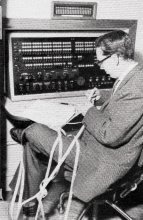Dreams about the Computer
01. May. 2008

Electric Living - catalogue from the exhibition in Forum in 1957.
Charles Babbage
The programming of Babbage's analytical machine took place with punched cards containing the code for the programme. Not only could the machine be programmed in advance for a certain task, but it was possible to currently change the programming without changing the machine itself, and that was an important innovation in comparison with existing machines.
The Forerunner of Modern Computers
Babbage's analytical machine was steam-powered, made of brass, 30 metres long and 10 metres wide, but nonetheless it was the forerunner of present-day computers. Unfortunately, the machine could not be completed due to lack of financing. However, Babbage kept working on the idea until his death in 1871 with so great confidence in its realization that he wrote in his autobiographical note: "As soon as an analytical engine exists, it will necessarily guide the future course of science" Today many research projects are totally dependent on computers so his dream of the future proved to come true.

Aage Melbye controlling data at the general election in 1960. The Danish Institute of Computing Machinery had been asked by the Danish Broadcasting Corporation to help making prognoses and calculating the distribution of seats by means of DASK. It was the intention that the results should be telephoned to the Broadcasting House in Rosenørns Allé, but it did not work. The results were therefore sent by taxi from Valby to the Broadcasting House, hoisted up in a basket in order to save time, and then handwritten on signs which were hung up in the studio for the population to see on their television screens.
A World Market for five Computers
The earliest computers of the 20th century were not very different from Charles Babbage's analytical machine with regard to size or functions. Whether it was the mere size of the machines that in 1943 made chairman of IBM Thomas Watson predict a world market for not more than five computers, we do not know. What we do know is that he was wrong.
The First Danish Computer
The first Danish computer, DASK (Danish Arithmetic Sequence Calculator), was developed by the first IT company in Denmark, the Danish Institute of Computing Machinery, and filled an entire villa in Valby. Like Babbage's machine DASK used punched cards for its calculations of which some of the earliest took place at the large fair in Forum in 1957 - Electric Living. To demonstrate the masterly calculating ability of the machine, the public could bring their statements and the machine would then calculate their tax rate. Or rather: The figures were sent by telephone between Forum in Frederiksberg and Valby as DASK was not easily moved.
The Computer as a Life Nerve
Today the computer has become an integrated part of most people's everyday life and no matter if we have one at home or not, it influences our everyday life and almost everything that surrounds us - at work, in the traffic, at school, and in our leisure time. In this way our reality is far from the following prediction which was propounded at a conference about the future in the United States in 1977: "There is no reason anyone would want a computer in their home."
The story is included in the Dream Trail which can be experienced in the museum's permanent exhibition.
This article may be copied or quoted with MuseumsPosten, Post & Tele Museum as source.
Comment this article
Only serious and factual comments will be published.